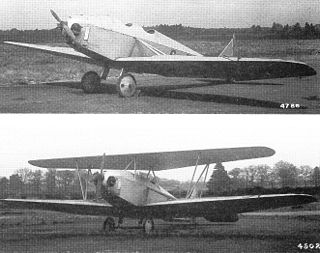
Blackburn Aircraft Limited was a British aircraft manufacturer that concentrated mainly on naval and maritime aircraft during the first part of the 20th century.

The Blackburn Iris was a British three-engined biplane flying boat of the 1920s. Although only five Irises were built, it was used as a long-range maritime reconnaissance aircraft by the Royal Air Force, where it equipped a squadron for four years, being used to carry out a number of notable long-distance flights. The final version of the Iris, the Iris Mark V was developed into the aircraft that replaced it in Squadron service, the Blackburn Perth.

The Armstrong Whitworth AW.15 Atalanta was a four-engine airliner designed and produced by the British aircraft manufacturer Sir W.G. Armstrong Whitworth Aircraft Limited at Coventry.
The de Havilland Moths were a series of light aircraft, sports planes, and military trainers designed by Geoffrey de Havilland. In the late 1920s and 1930s, they were the most common civilian aircraft flying in Britain, and during that time every light aircraft flying in the UK was commonly referred to as a Moth, regardless if it was de Havilland-built or not.

The Supermarine Air Yacht was a British luxury passenger-carrying flying boat. It was designed by Supermarine's chief designer R. J. Mitchell and built in Woolston, Southampton in 1929. It was commissioned by the brewing magnate Ernest Guinness, and was the first British flying yacht built to the order of a private owner. Only one machine was built.

The Saro Cloud was a British passenger amphibian flying boat designed and built by Saunders-Roe as the A.19. It was later produced as the A.29 for the Royal Air Force for pilot and navigator training.
The Blackburn F.1 Turcock was a British single-seat single-engine biplane fighter built in 1927. Designed to be produced in several variants, only one was completed.

The Blackburn R.2 Airedale was a single-engine three-seat monoplane deck-landing aircraft for land and sea reconnaissance, built in the UK in 1924. Only two were built.

The Blackburn T.R.1 Sprat was a British single-engine two-seat biplane trainer, built in 1926 for advanced training, deck-landing and seaplane experience. Just one was built.

The Blackburn 2F.1 Nautilus was a British single-engine two-seat biplane spotter/fighter built in 1929. Only one was completed.

The Blackburn B.T.1 Beagle was a British single-engine, two-seat biplane bomber/torpedo aircraft from 1928. Designed to Air Ministry specifications which led to no contracts for any manufacturer, only one Beagle was built.
The Blackburn Second Monoplane was strongly influenced by the French Antoinette and was much more successful than Robert Blackburn's first aircraft. The lone aircraft was built in Leeds, UK in 1910.

The Blackburn White Falcon was a two-seat single-engine monoplane built as a personal transport for Blackburn's test pilot during the First World War. Only one was built.

The Vickers Viastra was an all-metal 12-seat passenger high-wing monoplane, with variants powered by one, two and three engines. Two twin-engined Viastras operated commercially in Australia from 1931-6; another served as a Royal transport.
The de Havilland DH.72 was a large British three-engined biplane bomber, designed as a Vickers Virginia replacement. It did not go into production.

The Fairey G.4/31 was a British single-engined, two-seat biplane contender for an Air Ministry specification for a multi-role or general purpose aircraft. Unsuccessful, only one was built.

The Parnall Pixie was a low powered British single-seat monoplane light aircraft originally designed to compete in the Lympne, UK trials for motor-gliders in 1923, where it was flown successfully by Norman Macmillan. It had two sets of wings, one for cross-country flights and the other for speed; it later appeared as a biplane which could be converted into a monoplane.
The Parnall Perch was a single-engined, side-by-side-seat aircraft designed in the UK to meet an Air Ministry specification for a general-purpose trainer. No contract on this specification were awarded and only one Perch was built.
The Blackburn Type E was a development of the earlier Blackburn Mercury single-engined monoplanes, but was innovative in its use of steel tubing to construct the fuselage. It was built during 1912 to compete in the Military Aeroplane Trials. A single-seat version flew, but the military two-seater did not.
The Junkers J 15 was an all-metal monoplane built in Germany in 1920 to explore the design parameters of small single-engined passenger transports. In particular, it could fly in either high or low wing configurations. It led to the Junkers J 16 light airliner.














